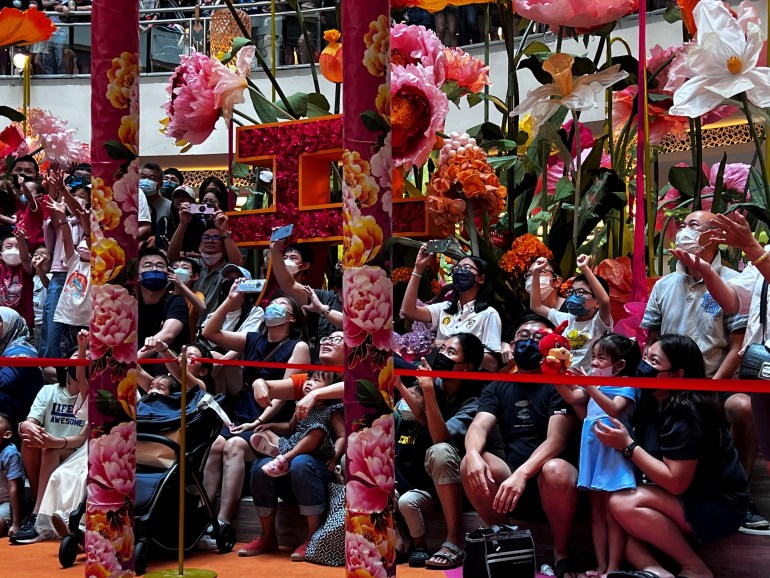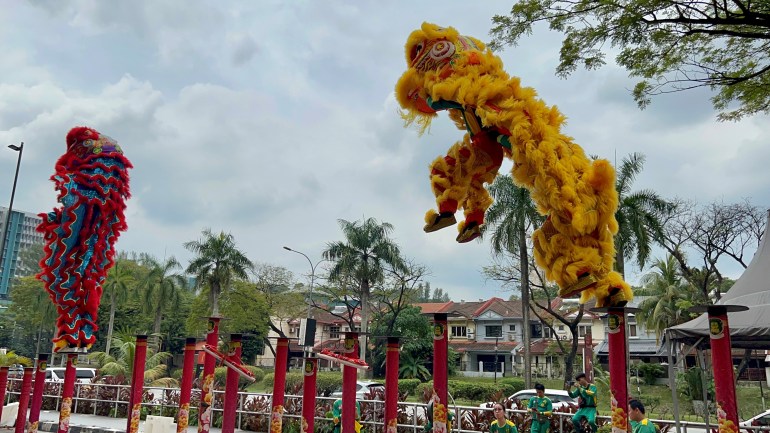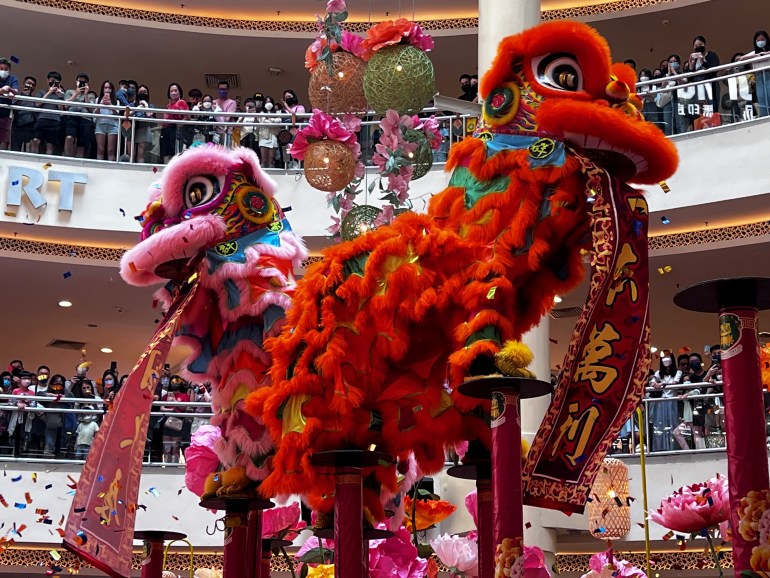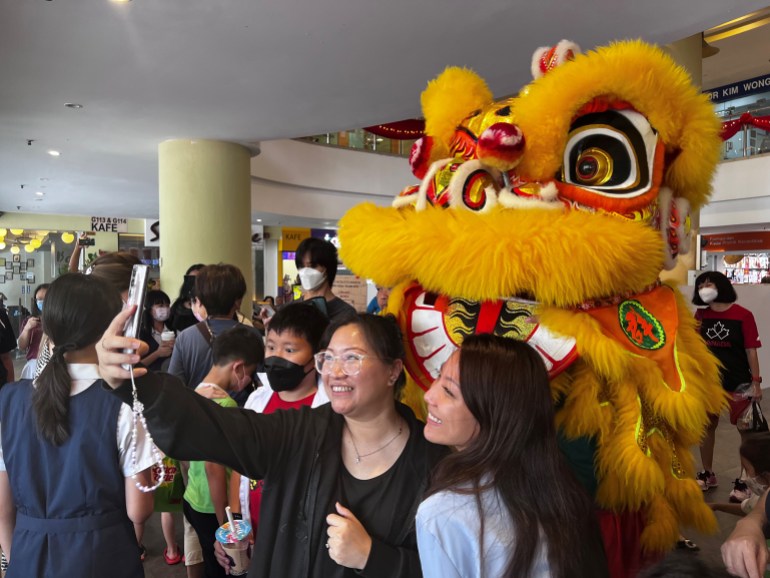Malaysian lion dancers bring new spirit to ancient tradition | Arts and Culture News
Kuala Lumpur, Malaysia – When her maternity leave ended, Mariam Abdul Nazar returned to work and her passion, lion dancing.
A Malaysian Muslim, she started learning lion dancing when she was 13, after accompanying her then 14-year-old brother to his training sessions.
“I was drawn to the energy from the music, especially the drums. And I thought the lions were cute, with their big, big eyes,” Mariam, a 27-year-old content reviewer, told Al Jazeera.
In multiracial Malaysia, lion dancing has become so popular that it is not just the country’s ethnic Chinese taking up the art.
The Muhibah Lion Dance Troupe, established in 1984, is the first multiracial lion dance group in the country. Its name, Muhibah, is from the Malay word “muhibbah”, which means a feeling of friendship or camaraderie.

At the Khuan Loke Dragon and Lion Dance Association, where Mariam trains, her teammates are made up of Malays, the ethnic majority in Malaysia, Indians, an ethnic minority, and a handful of foreigners.
Now a working adult and a new mum, Mariam finds it difficult to commit to the three-times-a-week training schedule, but she returns to help out during the Lunar New Year, one of the busiest times for lion dance troupes in Malaysia.
Festive mood
The lion is a traditional symbol of good luck in Chinese culture and lion dancing is believed to usher in good luck and prosperity while driving away evil and bad luck.
Chinese families and Chinese-owned businesses hire lion dancers to perform in their homes and offices, believing it will bring good fortune for the rest of the year.
Shopping malls also hire lion dance troupes to put on shows throughout the 15-day celebration as well as in the weeks leading up to the Lunar New Year.
There are Facebook pages dedicated to tracking where and when performances are held.
Sarah Thiang and her family try to catch at least one show every year.
“It’s part of Chinese culture. It’s fun and really puts me in a festive mood,” she said, watching an acrobatic performance in a shopping mall.
“It’s a bit nerve-racking watching them [the lion dancers] on high poles, but I wasn’t worried for them. I have confidence in their ability,” she added.

The acrobatic lion dance is performed on high poles ranging from one to three metres in height.
Performers have to be agile and strong, and every move has to be perfectly coordinated.
A misstep or a mistimed move could result in serious injury.
The lion dance tradition may have originated in China some 1,000 years ago, but it is Malaysia that is setting the pace and Kuala Lumpur that is considered the lion dance capital of the world.
Performing on high poles is a relatively new development, invented in the 1990s by Malaysian Siow Ho Phiew, who later created a high pole sequence that became the new standard in acrobatic lion dance worldwide.
Siow, or Master Siow as he is often called in a nod to his expertise, is also a master craftsman of lion heads and a world-renowned coach.
One of his students is Harlen Lee, owner and head instructor at Gee Yung International Martial Arts, Dragon and Lion Dance Sports Association in Hawaii in the United States.
Lee remembers a time when lion dancing was mostly performed by and for people in the Chinese community.
“Now, almost every country has a lion dance team. That’s pretty awesome, that our culture, our background has touched other cultures. I’m proud of that,” said Lee, who is based in Honolulu.
He makes it a point to return to Malaysia every year to train with a local team, and if he is unable to do so, he sends one of his students instead.
“Just being in that atmosphere, going into the heart of learning lion dance mastery, helps us improve,” Lee said.
Music is the ‘heartbeat’
“One of the reasons Malaysian lion dance teams keep winning competitions is because our lions are life-like, they have spirit,” said Eric Fong, secretary general and coach of Khuan Loke.

Fong, who also judges lion dance competitions, says the art of lion dancing is not only about performing stunts but also about the ability to convey emotions.
A flap of the ears, a flutter of the eyelids — these gestures can be used to express playfulness, excitement or ferocity.
At Khuan Loke, all lion dance performers start by learning to play the instruments — the drums, the cymbals and the gong.
“The music is the heartbeat of a lion dance,” Fong explained. “There is no shortcut.”
The training and the performance schedule are gruelling.
It often means Fong and his team have to skip almost all Lunar New Year celebrations, save the traditional family reunion dinner held on the eve of the festival.
Fong says his family have gotten used to seeing little of him during a time when family gatherings are cherished.
“They are more understanding now. It’s not like I’m doing anything bad. I’m keeping tradition alive, and I’m doing something that all Malaysians can be a part of,” he said.


Pingback: สินเชื่อโฉนดที่ดิน
Pingback: Dnabet.com
Pingback: purple pugs breath strain
Pingback: ดูซีรี่ย์ออนไลน์
Pingback: ai nude
Pingback: Conventional Tank Water Heater Repair Plumbers Near Me
Pingback: สวนหิน
Pingback: นิยาย
Pingback: Mostbet
Pingback: sansiri.com.au